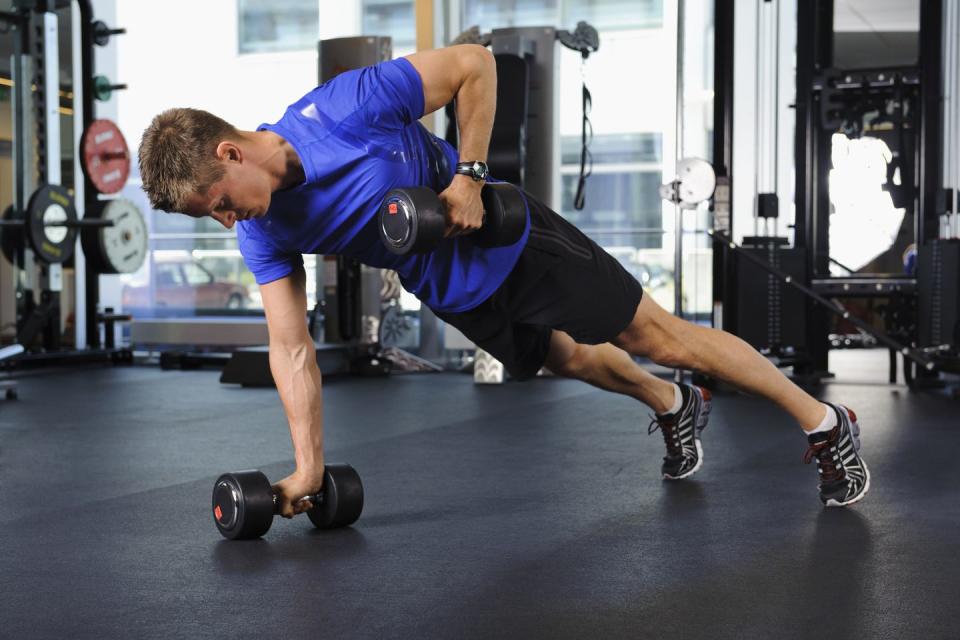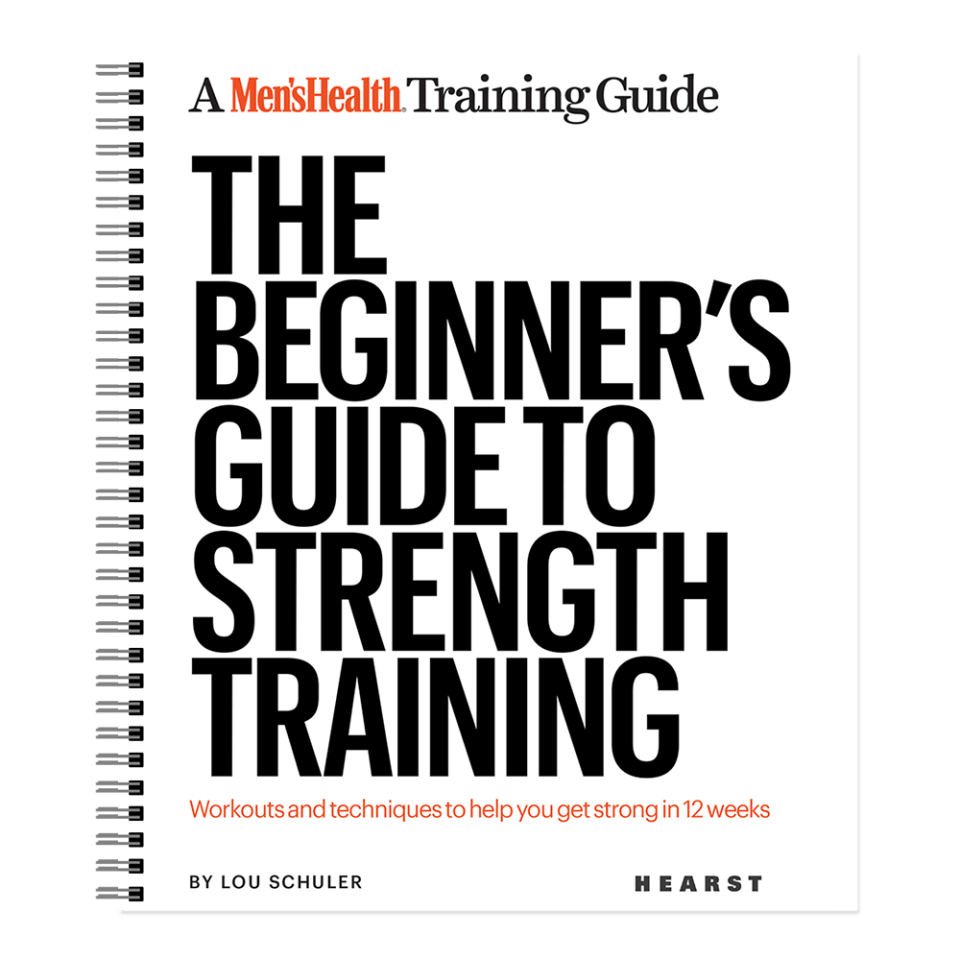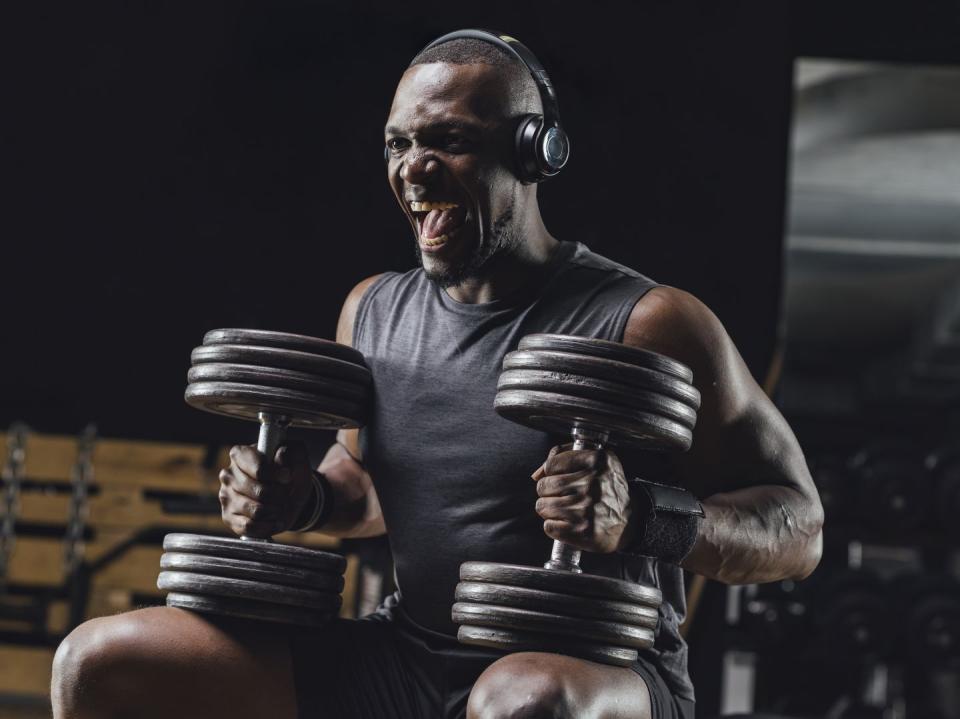The Beginner's Guide to Weight Training
SO YOU'VE DECIDED it's time to get in shape and start lifting weights. That's great—taking the first step and making a choice to start a new routine is the only way you can make a change. How exactly you should go about your new weight training plan, however, can be confounding to navigate at the start. You're bound to be bombarded with all kinds of advice, from the old school weight room creatures who are happy to dispense obscure tips and tricks to fitness influencers and YouTube creators flooding your social media feeds with non-stop workout content. Unfortunately, not all of it will be good. Some of it will be downright bad.
That's why you're here. This no-nonsense weight training guide will give you all the information you need to confidently step into the gym to get started on your journey to build strength and muscle. There are simple principles and concepts you should know before you start and answers to your most important questions.
Not everyone will have the same path in the gym, but the basics to weight training will be the same: Your main objective is to lift increasingly more challenging loads—with proper form—to pack on muscle and forge strength. Your goals and approach might shift as time passes and you home in on new strength and aesthetic goals, but it all goes back to that simple truth. Weight training is about challenging yourself to do more and pushing through comfort zones.
Not that weight training is always easy or intuitive. Sure, it makes sense that a few dumbbell curls for your biceps will grow big biceps, but why the heck is it taking so long? How do you make it happen faster? And what’s the best starter’s workout if you’re into weight training?
Read on, and we’ll answer all those questions (and more).
[table-of-contents] stripped
What Is Weight Training?
Simply put, weight training is training your body with external weights, typically implements like dumbbells, kettlebells, and barbells. Doing exercises with these weights forces your body to adapt to loads greater than those it faces on a regular basis, and the adaptations your body makes to move those loads leads to more muscle and strength.
Worth noting, though: Weight training isn’t the only way to challenge your body to new loads. Any form of resistance training offers a chance for you to expose your body to new loads. Weight training is just one form of resistance training; bodyweight training and resistance band training also offer opportunities to challenge your body to pack on size.
Will Weight Training Build Muscle?

Weight training will help you build muscle. You'll need to make sure to fuel your body properly and recover well to optimize this process, but muscle gains are going to be one of the main results of your weight training plan. As you build that muscle, you’ll reap other benefits, too. First off, you’ll insulate your body against injuries; the more muscle you build, the more you’ll help tighten and stabilize your joints. This is especially true for two of your largest ball-and-socket joints, the hip and shoulder. Building muscle in the right places can help stabilize both joints, which often grow brittle with age and lack of use (which happens frequently in today’s desk job-driven culture).
You’ll also enhance overall body coordination as you gain increased control over the muscles you train.
Will Weight Training Burn Fat?

The Beginner's Guide to Strength Training
Men's Health
$12.47
Men's HealthWhether or not your workouts burn fat depends on how exactly you’re integrating weight training into your routine. In general, though, it won’t burn as much fat as a workout whose sole purpose is to ramp up your heart rate, such as a running workout. But weight training is increasingly blended into high-intensity interval (HIIT) circuits; these ramp up your heart rate while also challenging you to move weights
Additionally, while weight training alone may not speed fat loss, the gains that come with weight training will indirectly assist in your fat loss. A more muscular frame will have a faster metabolism, speeding regular calorie burn and helping you burn more fat throughout the day.
How Long Before Weight Training Will Yield Progress?
This depends on many factors, including your starting point, your age, and your nutrition. Don’t expect to look like a superhero in a month, no matter what the Internet tells you. Building muscle takes time, and the aesthetics are often the last thing to come.
You will make initial strength gains quickly. You’ll see progress in other regions too. Expect to see your coordination and body control improve just a few weeks after you start weight training, and you’ll see yourself moving heavier weights rather quickly. Eventually, however, you’ll hit a plateau.
What’s a Plateau and How Do I Beat It?
A “plateau” occurs when you stop seeing rapid progress in your training. This can occur in weight training or in any other brand of training in the gym. Plateaus are hard to get past, even for seasoned lifters.

Generally, these roadblocks occur because the body has grown too familiar with the current training protocol and needs a new workout, so often, changing the order of exercises, the training style, or even the tempo of each rep can assist you in crushing a plateau.
How Often Should Beginners Weight Train?
No matter how many social media stars push for a "no days off" mentality for progress, that should never be your approach. Beginners should give their body plenty of time to rest and recover between workouts. A three-day split is a great place to start, making sure to slot in a rest day between every training day.
How Many Reps Should Beginners Lift?
This depends on the goal. If you’re aiming to add pure strength and power, so that you can move more weights or pick up your couch more easily, you want to think of doing 3 to 6 reps of each exercise. If you want to build muscle, aim to do 8 to 12 reps per set. If you simply want to hone muscular endurance, think of doing more than 12 reps per set.
Your rep count also depends on the exercises you’re doing. Exercises like bench presses and squats are easily trained in low-rep ranges, taxing the body after just a few reps. More detail-focused exercises, like lateral shoulder raises, are often best done in sets of 10 to 15 reps to protect your joints.
What Muscles Should Beginners Train?
All of them. Don’t fall into the trap of only training the muscles you want to “grow” or only training the muscles that respond to training, or skipping out on training certain body parts (skipping “leg day” will get you on a meme very quickly).
A well-rounded training program has you hitting all major muscle groups, which is key to long-term health and will also help you build a truly noticeable beach body. Not sure how to build that? Aim to do at least three things in your workouts weekly: Train legs, push some weight (think bench press), and pull some weight (think of dumbbell or barbell rows).
The Best Weight Training Exercises for Beginners
These exercises can be the bedrock of any beginner's weight training program.
Dumbbell Incline Row
Why: This back exercise is a rowing variation that helps to teach beginners how to squeeze their shoulder blades and pull them back, with some extra support from the bench that will take strain off the lower back and reinforce good posture.
How to Do It:
Sets and Reps: 3 sets of 8 to 10 reps
Dumbbell/Kettlebell Romanian Deadlift
Why: This exercise, which helps to strengthen the hamstrings and glutes, will help to establish the hip hinge, an all-important movement pattern for lower body exercises. Starting with the weights at the hips (rather than from the floor in a deadlift) will help you to figure out your personal range of motion.
How to Do It:
Standing with you feet about shoulder-width apart, grab a pair of dumbbells from a bench or box.
Keep the dumbbells close to your sides, with your shoulders back, your core tight, and glutes squeezed.
Begin “pushing” your butt back as far as possible as you begin lowering your torso—as if you’re trying to close a car door. Think about taking two seconds with the lowering phase. The goal is to get to about a 45-degree angle, depending on your personal mobility limits. Don’t forget to keep the dumbbells close to your shins—don’t let them hang too far forward.
Pause at the bottom, then stand back up, slightly quicker than the lowering phase.
Sets and Reps: 3 to 4 sets of 6 to 8 reps
Farmer's Carry
Why: There's no more basic exercise than this: Pick up heavy load, then walk. You'll be conditioning your body to lift heavy loads here, honing your grip strength and posture. There are plenty of takeaways for the gym and the real world.
How to Do It:
Grab a pair of weights in each hand. Grip as firmly as possible.
Stand up straight, squeezing your shoulder blades, abs, and glutes. Keep your gaze focused just ahead of you on the floor to maintain a neutral spine.
Walk forward, keeping your posture intact. Don't allow your arms to swing or your shoulders to stoop.
Sets and Reps: 2 to 3 minutes of 30 seconds on, 30 seconds off
Parallel Pause Biceps Curl
Why: One of your immediate goals is probably building big arms. One of the easiest, most effective ways to do that is the biceps curl. This variation, however, teaches beginners how to establish the mind-muscle connection, which is key for muscle gains.
How to Do It:
Stand with your feet hip-width apart, holding a pair of dumbbells in a neutral grip (palms facing each other). Squeeze your shoulder blades, abs, and glutes to create full-body tension.
Curl the dumbbell up with both hands, moving only at the elbow joints. Keep your upper arms still and perpendicular to the floor.
As you curl up, rotate the dumbbell inward so that your palm faces the sky. The weight should be parallel to the floor by the time you reach the halfway point.
Continue raising the weight up, squeezing the biceps at the top of the movement.
Lower the weight back down with control. When your arms are parallel to the floor (about the halfway point), pause and hold the weight level for a count, squeezing the biceps.
After the pause, lower back down to the start.
Sets and Reps: 3 sets of 8 to 10 reps
The Weight Training Beginner's Workout Routine
Do this routine three days a week. Rest at least one day between workouts. You'll be focusing on key exercises to build total-body muscle.
Dumbbell Row
Why: Back training is key for everything from balanced strength, posture, and a balanced physique, and this dumbbell row is one of the simplest exercises that allows you to build up strength and muscle. For more lower back support, swap with the inline bench version above.
How to Do It:
Stand with your feet at shoulder width apart in front of the bench. Push your butt back and lower your torso down, extending your off arm to rest your palm on the bench. Make sure your shoulders stay above your hips.
Grab the dumbbell with your working hand. Squeeze your glutes and abs to create full-body tension. Your back should be flat, with your head in a neutral position.
Squeeze your mid-back muscles to drive your elbow up, rowing the weight. Keep your shoulders level and avoid rotating your lower back.
Pause for a beat, then lower the weight back down.
Sets and reps: 3 sets of 10 to 12 reps per side
Dumbbell Bench Press
Why: This chest-training staple is a key exercise for upper body strength. Swapping out the common barbell for dumbbells is a great way for beginners to learn the movement within a less rigid range of motion.
How to Do It:
Lie back on the bench, holding a pair of dumbbells at your chest. Your elbows should be at a 45 degree angle relative to your torso. Drive your shoulder blades down into the bench, then squeeze your abs, and glutes, then plant your feet firmly on the floor.
Press the dumbbells straight up above your chest. Don't knock the weights together at the top.
Lower back down to your chest with control.
Sets and Reps: 3 sets of 8 to 10 reps
Deadlift
Why: You're working the hip hinge, which is important for lower body training more broadly, and challenging your hamstrings and glutes. If you don't feel comfortable, swap the barbell deadlift with the dumbbell Romanian deadlift above.
How to Do It:
Step up to the loaded barbell with your feet about shoulder-width apart and feet under the bar.
Push your butt back and hinge at the waist to bend down to grab the bar on either side of your legs. Grasp it in both hands using an overhand grip.
Make sure your hips are lower than your shoulders. Squeeze your shoulder blades together to set your lats, then engage your core. Keep your neck in a neutral position; don't look up.
Push your feet through the floor and pull the weight up, keeping the bar close to your body. You might find that you scrape your shins with the bar, that's okay. Invest in long socks or wear pants. Squeeze your glutes at the top of the list, but don't lean back.
Sets and Reps: 4 sets of 8.
Goblet Squat
Why: The goblet squat is our pick for the best option for beginners to learn good squat mechanics with a load. The front-loaded position is ideal to reinforce good posture, and you can use any type of equipment you have on hand.
How to Do It:
Take a comfortable stance and grab your weight, holding it in front of your chest with both hands. Squeeze your shoulder blades to create mid-back tension to help support the load.
Before you descend into the squat, take a deep breath and brace your core. This will help you to avoid tipping too far forward.
Push your butt back, then bend your knees to squat down as low as you comfortably can while maintaining the proper upright posture. Push your knees out and keep your core engaged; don't rest your elbows on your knees.
Press off the floor with both feet to stand back up, squeezing your glutes and exhaling at the top.
Sets and Reps: Do 4 sets of 8 to 10
You Might Also Like

